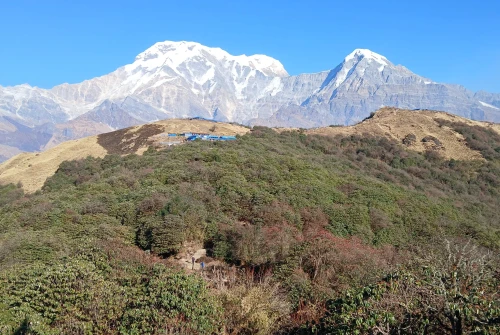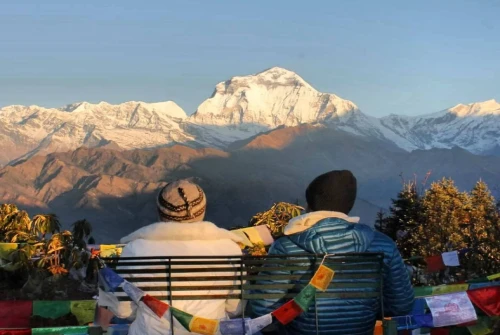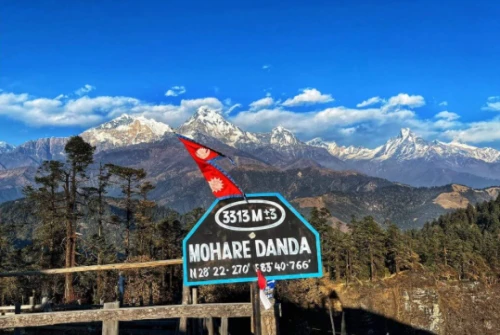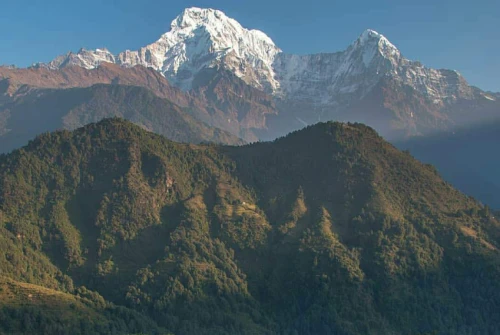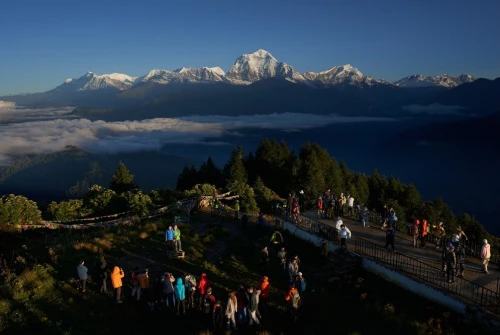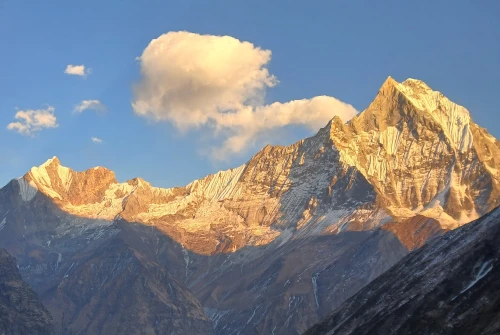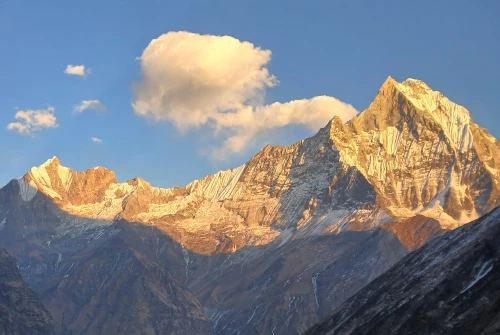Duration:15 Days Annapurna Base Camp Trek - 15 Days
US$925US$1299Duration:11 Days Annapurna Circuit Trekking - 11 Days
US$775US$1149Duration:3 Days Poon Hill Trek - 3 Days
US$230US$330Duration:4 Days Muldai Viewpoint Trek – 4 Days
Duration:11 Days Khopra Danda Trek - 11 Days
US$635US$1030Duration:4 Days Poon Hill Sunrise Trek – 4 Days
Duration:6 Days Mohare Danda Trek – 9 Days
Duration:8 Days Luxury Ghorepani Ghandruk Trek – 8 Days
Duration:12 Days Annapurna Base Camp with Poon Hill Trekking -12 Days
US$799US$1099Duration:5 Days Poonhill Trek - 5 Days
US$315US$415Duration:5 Days Annapurna Base Camp Trek - 5 Days
US$399US$549Duration:10 Days Annapurna Base Camp Trekking- 10 Days
US$699US$949Duration:7 Days Annapurna Base Camp Trek-7 Days
US$390US$590Duration:14 Days Annapurna Circuit Trek-14 Days
Duration:15 Days Annapurna Circuit Trek- 13 Days
US$915US$1199Duration:13 Days Annapurna Circuit Trek for Indians
Duration:8 Days Annapurna Circuit Trek - 8 Days
Duration:11 Days Poon Hill – Ghandruk Trek - 11 Days
US$699US$799Duration:9 Days Mardi Himal Trek-9 Days
US$499US$799Duration:7 Days Mardi Himal Trek - 7 Days
US$599US$849Duration:5 Days Mardi Himal Trek - 5 Days
US$249US$449Duration:7 Days Khumai Danda Trek - 7 Days
US$499US$749Duration:3 Days Khumai Danda Trek - 3 Days
US$249US$399Duration:9 Days Machhapuchhre Model Trek
US$649US$849Duration:20 Days Annapurna Seven Passes Trek
US$1875US$2349Duration:7 Days Khopra Ridge Trek - 7 Days
US$699US$899Duration:17 Days Annapurna Circuit Trek with Tilicho Lake Trek - 17 days
US$999US$1999Duration:17 Days Annapurna Circuit via Nar Phu Valley Trek - 16 Days
US$1212US$1399Duration:12 Days Annapurna North Base Camp Trek - 12 Days
The Annapurna Region, nestled in the central Himalayas of Nepal, stands as one of the most iconic, scenic, and diverse trekking destinations in the world. Renowned for its soaring snow-capped peaks, rich cultural heritage, and incredible biodiversity, this region offers a truly unparalleled Himalayan experience for adventure seekers, nature lovers, and cultural travelers alike.
At the heart of this legendary landscape lies the Annapurna Massif, a majestic range that dominates the skyline with its towering summits. Central to this massif is Annapurna I (8,091 meters) the 10th highest mountain on Earth and the first 8,000-meter peak ever successfully climbed. Surrounding it are a series of awe-inspiring mountains rising above 7,000 meters, including the sacred Machapuchare (Fishtail Mountain), the mighty Dhaulagiri (8,167m), the striking Nilgiri Himal, Gangapurna, Annapurna South, and Hiunchuli.
What makes the Annapurna Region so exceptional is its diversity of trekking options, ranging from short and easy hikes like the Ghorepani Poon Hill Trek to demanding high-altitude adventures such as the Annapurna Circuit Trek and the Annapurna Base Camp Trek. The trails traverse a wide range of ecosystems and terrains from terraced farmland and rhododendron forests to glacial moraines and alpine meadows offering a dynamic trekking experience with every step.
Whether you're a beginner looking for a short scenic trek near Pokhara or an experienced hiker ready to conquer Thorong La Pass (5,416m), the Annapurna Region caters to every level of trekker. Along the way, you’ll discover traditional Gurung and Magar villages, ancient Buddhist monasteries, and jaw-dropping viewpoints offering panoramic vistas of the Himalayan range.
With its exceptional natural beauty, cultural richness, and world-class trekking infrastructure, the Annapurna Region remains one of the best trekking destinations in Nepal and indeed, the world.
Why Choose the Annapurna Region?
The Annapurna Region is more than just a trekking destination; it's a complete immersion into the breathtaking beauty, cultural richness, and spiritual depth of the Himalayas. Here’s why it remains one of the top trekking regions in Nepal and a bucket-list adventure for hikers from around the globe:
Unmatched Himalayan Scenery
Trek through landscapes dominated by world-famous peaks such as Annapurna I (8,091m), Machapuchare (Fishtail), Dhaulagiri, and Nilgiri each offering panoramic views, stunning sunrises, and dramatic high-altitude vistas. From lush green hills to icy glaciers, every trail offers a photographer’s dream and a trekker’s paradise.
Trekking for Everyone – From Beginners to Experts
Whether you're a first-time hiker or a seasoned mountaineer, the Annapurna Region offers a route for you:
- Short treks like the Ghorepani Poon Hill Trek, Royal Trek, and Australian Camp Hike are perfect for families and casual walkers.
- Moderate treks like the Mardi Himal Trek and Annapurna Base Camp Trek (ABC) provide adventure without extreme altitude.
- Challenging treks like the Annapurna Circuit or Tilicho Lake Trek satisfy those seeking high passes, remote valleys, and rugged alpine landscapes.
Incredible Biodiversity
As part of the Annapurna Conservation Area, the region is home to:
- Over 1,200 plant species
- Rare wildlife like snow leopards, red pandas, musk deer
- More than 450 bird species, including the beautiful Himalayan monal
Trek through rhododendron forests, alpine meadows, and subtropical jungles, all in a single journey.
Rich Cultural and Spiritual Heritage
Walk through traditional villages inhabited by Gurung, Magar, Thakali, and Tibetan-influenced communities. Experience:
- Buddhist monasteries and Hindu temples
- Authentic teahouse stays run by locals
- Participation in vibrant festivals like Dashain, Tihar, and Losar
This is not just a hike, it’s a chance to connect with Himalayan life and traditions that have lasted for centuries.
Excellent Trekking Infrastructure
The Annapurna Region is one of the most accessible and well-managed trekking areas in Nepal, offering:
- Easy access via Pokhara, Nepal’s second-largest city
- A reliable network of teahouses and lodges
- Well-marked trails, rescue services, and local guides
- Availability of trekking permits (ACAP & TIMS) in both Kathmandu and Pokhara
It’s perfect for independent trekkers and those who prefer guided treks alike.
A Journey That Changes You
The Annapurna experience is about more than physical achievement:
- Challenge yourself with dramatic terrain and high-altitude passes
- Find peace in sacred landscapes and quiet forests
- Meet people from all over the world who share your passion for adventure
Every trek in this region becomes a personal and spiritual journey one that leaves a lasting imprint on your life.
Most Popular Treks in the Annapurna Region
The Annapurna Region offers some of the most diverse and breathtaking trekking routes in Nepal. From long, challenging circuits to short, family-friendly hikes, these treks showcase the stunning natural beauty and rich cultural heritage of the Himalayas. Here are the most popular treks that every adventurer should consider:
Annapurna Circuit Trek
The Annapurna Circuit Trek is a legendary and challenging high-altitude trek that spans approximately 160 to 230 kilometers, depending on the route taken. This epic journey circumnavigates the Annapurna massif, offering trekkers an incredible diversity of landscapes, cultures, and natural beauty. Beginning from lush subtropical rice terraces and dense pine forests, the trail gradually ascends to the stark, arid trans-Himalayan plateau of Mustang, showcasing Nepal’s unparalleled ecological and geographical variety.
One of the trek’s most iconic features is the Thorong La Pass (5,416 meters), one of the highest trekking passes in the world, demanding physical endurance and offering breathtaking panoramic views of snow-capped Himalayan peaks. The trek also includes a visit to Tilicho Lake, the world’s highest glacial lake situated at an altitude of 4,919 meters, renowned for its pristine turquoise waters surrounded by towering peaks.
Along the route, trekkers encounter rich cultural heritage through traditional Hindu and Buddhist sites, such as the sacred Muktinath Temple, a pilgrimage site revered by both religions. The trail also passes through important towns and villages including Manang, Pisang, Kagbeni, and Jomsom, each offering unique local culture, hospitality, and stunning mountain vistas.
The entire trek rewards adventurers with panoramic and awe-inspiring views of some of the Himalayas’ most majestic peaks: Annapurna I (8,091m), Dhaulagiri (8,167m), Machapuchare (Fishtail) with its distinctive shape, and the rugged Nilgiri range. The Annapurna Circuit Trek is truly a blend of natural grandeur, cultural richness, and high-altitude adventure, making it one of Nepal’s most sought-after trekking experiences.
Annapurna Base Camp Trek
The Annapurna Base Camp Trek is a spectacular journey that takes trekkers deep into the heart of the Annapurna massif, arriving at the iconic Annapurna Sanctuary at an elevation of 4,130 meters. This trek offers an immersive experience through a stunning variety of landscapes, including lush rhododendron forests, verdant terraced fields, and traditional Himalayan villages such as Chhomrong and Sinuwa, where trekkers can engage with the rich Gurung and Magar cultures.
One of the highlights of the ABC trek is the breathtaking panoramic views of some of the highest Himalayan peaks, including Annapurna I, Machapuchare (Fishtail), Hiunchuli, and Gangapurna, all framing the Annapurna Sanctuary, creating a natural amphitheater of towering snow-capped mountains.
A relaxing and rejuvenating stop along the way is the Jhinu Danda Hot Springs, where trekkers can soothe their tired muscles in natural geothermal waters surrounded by pristine nature—an ideal natural spa experience amidst the trek.
The ABC trek is highly accessible and well-suited for those seeking a shorter, yet highly rewarding trekking adventure. It strikes a perfect balance between challenge and comfort, with a well-established network of teahouses, lodges, and local hospitality, making it a popular choice for solo travelers, families, and moderate-level trekkers looking to experience the raw beauty of the Himalayas without the extended duration of longer treks.
Ghorepani Poon Hill Trek
The Ghorepani Poon Hill Trek is a popular short trek, typically lasting 4 to 5 days, celebrated for its breathtaking sunrise views over the Annapurna and Dhaulagiri mountain ranges from the famous Poon Hill viewpoint at 3,210 meters. This trek offers an accessible yet incredibly rewarding experience, making it perfect for beginners, families, and those with limited time.
Along the route, trekkers pass through vibrant rhododendron forests, which bloom spectacularly in spring, creating a vivid splash of colors. The trail winds through traditional Gurung villages where visitors can experience the warm hospitality and unique culture of the local Himalayan communities.
Overnight stays are typically in charming, rustic teahouses located in picturesque villages such as Ghandruk and Tadapani, offering a glimpse into rural mountain life alongside modern comforts.
The Ghorepani Poon Hill Trek is known for its combination of stunning natural beauty, cultural immersion, and easy accessibility, making it a top choice for anyone seeking a memorable yet manageable Himalayan trekking adventure.
Mardi Himal Trek
The Mardi Himal Trek is a quieter, less crowded trekking route in the Annapurna region, perfect for those seeking an off-the-beaten-path adventure. This trek offers spectacular ridge-line hiking with jaw-dropping panoramic views of some of the Himalayas’ most iconic peaks.
The journey leads trekkers up to the Mardi Himal Base Camp at an elevation of 4,500 meters, where you can experience close-up, breathtaking vistas of towering mountains such as Annapurna South, Hiunchuli, and the uniquely shaped Machapuchare (Fishtail Mountain).
Known for its peaceful trails surrounded by dense rhododendron and oak forests, the Mardi Himal Trek combines natural beauty with solitude, making it ideal for adventurers who want to escape the crowds and immerse themselves in the raw Himalayan wilderness.
Upper Mustang Trek
The Upper Mustang Trek takes you deep into the forbidden kingdom of Mustang, a unique and mystical rain-shadow desert located north of the Annapurna and Dhaulagiri mountain ranges. This trek offers a rare glimpse into an ancient Tibetan culture preserved for centuries, with visits to the walled city of Lo Manthang, sacred sky caves, and remote traditional villages.
Due to its cultural sensitivity and fragile environment, Upper Mustang is a restricted area requiring a special permit, ensuring responsible tourism and preservation of its heritage.
The best time to explore Upper Mustang is during the summer months from May to August, when the rest of Nepal is affected by monsoon rains, making this region ideal for dry, clear weather and spectacular desert landscapes.
Ecotourism & Conservation in the Annapurna Region
The Annapurna Conservation Area Project (ACAP) is a global model for sustainable tourism and community-based conservation. By reinvesting trekking permit fees directly into local development, ACAP supports vital initiatives such as education, healthcare, and sanitation for remote mountain communities, ensuring that tourism benefits those who live in this fragile ecosystem.
ACAP actively promotes forest and wildlife conservation, protecting endangered species like the snow leopard, red panda, and Himalayan monal, while preserving diverse habitats ranging from subtropical jungles to alpine meadows and glacial zones.
The project also prioritizes trail maintenance and waste management, encouraging responsible trekking by supporting eco-friendly lodges and minimizing plastic pollution. Trekkers are guided to respect local cultural customs and traditions, helping maintain the spiritual and cultural integrity of the Annapurna region.
Together, these efforts foster a harmonious balance between tourism, environment, and indigenous communities, making Annapurna a true ecotourism paradise.
Required Permits for Trekking in the Annapurna Region
To trek in the Annapurna Region, obtaining the necessary permits is essential for both regulation and conservation:
ACAP Permit (Annapurna Conservation Area Project) – NPR 3,000 (~USD 25): This permit helps fund local community development, conservation efforts, and trail maintenance across the Annapurna Conservation Area.
TIMS Card (Trekkers’ Information Management System) – NPR 2,000 (~USD 17): Mandatory for all trekkers, TIMS ensures safety and monitoring of trekkers in Nepal’s popular trekking regions.
Upper Mustang Restricted Permit – USD 500 (valid for 10 days): Due to its unique cultural and ecological sensitivity, trekking in Upper Mustang requires a special permit with limited access.
Permits can be conveniently purchased in Kathmandu and Pokhara, or arranged through authorized trekking agencies that handle logistics and documentation, making your adventure hassle-free.
Best Trekking Seasons in the Annapurna Region
The spring season (March to May) is one of the most popular times to trek in the Annapurna Region, offering mild temperatures, blooming rhododendron forests, and abundant wildlife sightings. However, trekkers should be cautious of occasional late snowfalls, especially at higher elevations like the Thorong La Pass.
Autumn (September to November) is considered the prime trekking season due to clear blue skies, excellent mountain visibility, and vibrant cultural festivals such as Dashain and Tihar. This season brings the best panoramic views of the Himalayas, but it is also the busiest, so early bookings for accommodation and permits are recommended.
The winter months (December to February) offer quieter trails, breathtaking snow-covered peaks, and a peaceful trekking experience. The downside is the harsh cold, and many high passes remain closed due to heavy snowfall, limiting access to some routes.
Finally, the monsoon season (June to August) is generally not recommended for most treks due to heavy rainfall, slippery trails, and the risk of landslides. However, it is the best time to explore the Upper Mustang region, a dry rain-shadow desert protected from the monsoon rains, offering unique landscapes and clear skies during this period.
Food, Lodging & Local Life in the Annapurna Region
Along the trekking routes, traditional teahouses provide hearty and authentic Nepali meals such as dal bhat (rice and lentil soup), Thakali cuisine, steamed momos, noodles, and locally made yak cheese. These dishes offer the perfect balance of energy and flavor to fuel your adventure.
Accommodations in the region are simple yet cozy, with many teahouses and lodges boasting spectacular mountain views that enhance the trekking experience. Warm hospitality and rustic charm make these stops a comforting refuge after a long day on the trail.
Don’t miss out on regional specialties like hot ginger lemon tea to soothe tired muscles, freshly baked apple pies in Marpha, or rich organic coffee grown in the hills of Ghandruk. These local flavors provide a taste of the diverse cultural and agricultural heritage of the Annapurna communities.


 based on 11 reviews
based on 11 reviews


